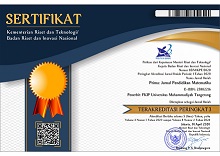ANALYSIS OF STUDENTS' MATHEMATICAL CREATIVE THINKING ABILITY IN THE MATH ESSENTIALS AT AN ISLAMIC MIDDLE SCHOOL IN BANDUNG
Abstract
Creativity is an important ability for students to have in the 21st century. The ability to think creatively is very important for innovation, developing original ideas, and finding new ways of thinking for students. In the context of mathematics, the mathematical creativity thinking ability to solve mathematical problems related to everyday life is important. However, the results of previous studies revealed that students' mathematical creative thinking abilities were still relatively low. This study aims to analyze the level of students' mathematical creativity thinking ability at an Islamic Middle School in Bandung. The research method used is descriptive-quantitative. The sampling technique used is purposive sampling. The subjects in this study were 17 eighth-grade students at an Islamic Middle School in Bandung. while the data collection techniques used are tests, questionnaires, and interviews. The test consists of four questions on math essentials based on indicators of mathematical creative thinking ability: fluency, flexibility, originality, and elaboration. The questionnaire consists of 15 closed statements based on 5 attitudes related to mathematical creative thinking abilities, namely: curiosity, imaginativeness, liking challenges, courage, and respect. Unstructured interviews were conducted as a validation of the results of the questionnaire. The results showed that the level of students' mathematical creative thinking ability was divided into 29% of students at level 3, 24% of students at level 2, 18% of students at level 1, and 29% of students at level 0.
Keywords
Full Text:
PDFReferences
Ardiansyah, A. S., & Asikin, M. (2020). Challenging students to improve their mathematical creativity in solving multiple solution task on challenge based learning class. Journal of Physics: Conference Series, 1-6. doi:10.1088/1742-6596/1567/2/022088
Arnidha, Y., & Hidayatulloh. (2019). Mathematical Representation of Deaf Students in Problem Solving Seen from Students' Creative Thinking Levels. Journal of Physics: Conference Series, 1-9. doi:10.1088/1742-6596/1155/1/012030
Desmayanasari, D., Hardianti, D., I. U., & Rohaeti, T. (2020). Mathematical creative thinking ability and problem centered learning. Journal of Physics: Conference Series, 1-7. doi:10.1088/1742-6596/1720/1/012004
Fasha, E. F. (2015). Pemahaman Konsep Esensial Matematis Melalui Belajar Aktif Pada Mata Kuliah Statistika. Dialektika, 2(2), 60-67. Retrieved from https://journal.peradaban.ac.id/index.php/jdpmat/article/view/106/104
Hayes, J. R. (1990). Cognitive Processes in Creativity. Occasional Paper, Carnegie Mellon University, Pittsburgh.
Isnani, S.B.Waluya, Rochmad, & Wardono. (2020). Analysis of mathematical creativity in mathematics learning is open ended. Journal of Physics: Conference Series, 1-5. doi:10.1088/1742-6596/1511/1/012102
Kemendikbudristek. (2021). BAHAN AJAR PROFIL PELAJAR PANCASILA. Jakarta: Kementerian Pendidikan, Kebudayaan, Riset, dan Teknologi.
Kemendikbudristek. (2022). PERUBAHAN ATAS KEPUTUSAN KEPALA BADAN STANDAR, KURIKULUM, DAN ASESMEN PENDIDIKAN KEMENTERIAN PENDIDIKAN, DAN KEBUDAYAAN, RISET, DAN TEKNOLOGI NOMOR 008/H/KR/22 TENTANG CAPAIAN PEMBELAJARAN. Jakarta: Kementerian Pendidikan, Kebudayaan, Riset, dan Teknologi.
Maulidia, F., Maulidia, F., & Andariah. (2019). A CASE STUDY OF STUDENTS’ CREATIVITY IN SOLVING MATHEMATICAL PROBLEMS THROUGH PROBLEM BASED LEARNING. Journal of Mathematics Education, 8(1), 1-10. doi:10.22460/infinity.v8i1.p1-10
McFarland, D., & Lewis, E. M. (1996). Introduction to Modern Mathematics. USA: D.C. Heath and Company.
Mulyaningsih, T., & Ratu, N. (2018). Analisis Kemampuan Berpikir Kreatif Siswa SMP dalam Memecahkan Masalah Matematika Pada Materi Pola Barisan Bilangan. Jurnal Ilmiah Pendidikan Matematika, 3(1), 65-74.
Mulyono, Rosayanti, S. M., & Kristiawan, R. (2020). Mathematics creative thinking ability based on student’s cognitive style by using Knisley learning models. Journal of Physics: Conference Series, 1-6. doi:10.1088/1742-6596/1567/3/032015
Munandar, U. (1992). Mengembangkan Bakat dan Kreativitas Anak Sekolah: Petunjuk Bagi Para Guru dan Orang Tua. Jakarta : PT. Gramedia.
Permatasari, S. D., Budiyono, B., & Pratiwi, H. (2020). Analysis of mathematical creativity in the field of geometry in junior high school students. Journal of Physics: Conference Series, 1-9. doi:10.1088/1742-6596/1469/1/012157
Ramelan, M., & Wijaya, A. (2019). A Comparative Analysis of Indonesian and Singaporean Mathematics Textbooks from the Perspective of Mathematical Creativity: A Case Statistics and Probability. Journal of Physics: Conference Series, 1-8. doi:10.1088/1742-6596/1320/1/012037
Schindler, M., & Lilienthal, A. J. (2020). Students Creative Process in Mathematics: Insights from Eye-Tracking-Stimulated Recall Interview. International Journal of Science and Mathematics Education, 1566-1586. doi:doi.org/10.1007/s10763-019-10033-0
Siswono, T. Y. (2010). LEVELING STUDENTS’ CREATIVE THINKING IN SOLVING AND POSING MATHEMATICAL PROBLEM. IndoMS. J.M.E, 1(1), 17-40.
Suyitno, A., Suyitno, H., Rochmad, & Dwijanto. (2019). Graph theory as a tool to track the growth of student's mathematical creativity. Journal of Physics: Conference Series, 1-4. doi:10.1088/1742-6596/1321/3/032119
Torrance, P. E. (1969). Creativity What Research Says to the Teacher. Washington DC: National Education Association.
DOI: http://dx.doi.org/10.31000/prima.v7i2.7455
Article Metrics
Abstract - 4365 PDF - 1131Refbacks
- There are currently no refbacks.
Prima: Jurnal Pendidikan Matematika
Program Studi Pendidikan Matematika
Fakultas Keguruan dan Ilmu Pendidikan
Universitas Muhammadiyah Tangerang
Jl. Perintis Kemerdekaan I/33, Cikokol
Kota Tangerang, Indonesia
e-mail: primajpm@gmail.com
Prima: Jurnal Pendidikan Matematika (p-ISSN: 2579-9827 | e-ISSN: 2580-2216) is licensed under a Creative Commons Attribution 4.0 International License.







